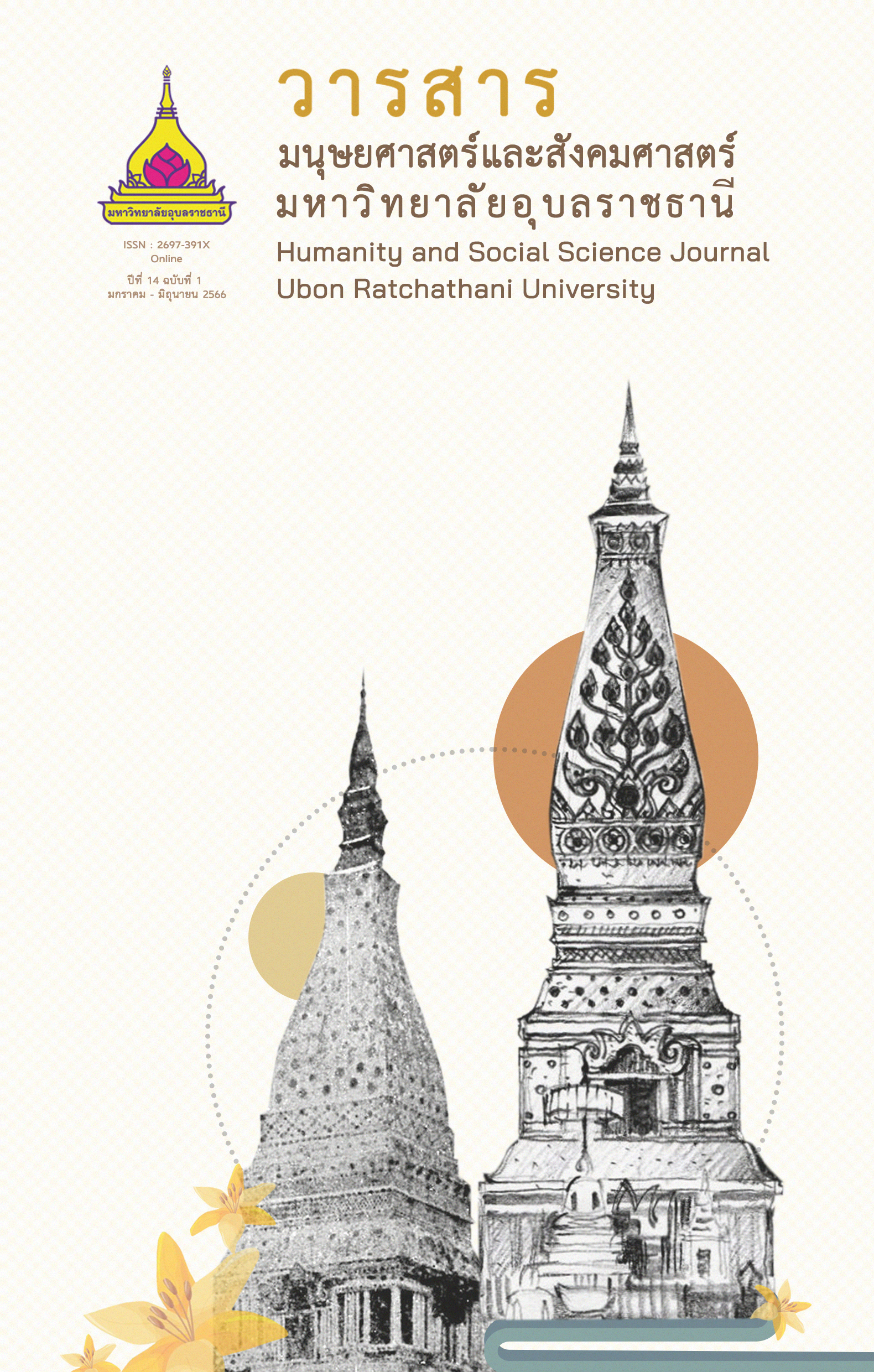ต่าง ๆ พื้นที่ในพื้นที่ต่าง ๆ: ความกำกวม การเปรียบเทียบ และการเล่น
Main Article Content
บทคัดย่อ
บทความวิจัยนี้ มีจุดมุ่งหมายเพื่อวิเคราะห์ทฤษฎีพื้นที่อื่นของฟูโกต์ และการทำงานของพื้นที่อื่นในพื้นที่นามธรรม โดยวิเคราะห์จากงานวิจัย 3 ชิ้น ซึ่งอยู่ในชุดโครงการวิจัย “พื้นที่อื่น ๆ ในพื้นที่อื่น: การทบทวนแนวคิดเรื่องพื้นที่อื่นในบริบททางประวัติศาสตร์ วรรณกรรม และวิดีโอเกม” ผลการวิจัยพบว่า ความกำกวม การเปรียบเทียบ และการเล่น คือองค์ประกอบของพื้นที่อื่นซึ่งฟูโกต์ไม่ได้กล่าวถึงในทฤษฎีดังกล่าว ความกำกวมตอกย้ำให้เห็นว่า พื้นที่อื่นตามแนวคิดของฟูโกต์นั้น ทำงานผ่านการปฏิเสธการมีอยู่ที่ปรากฏอย่างชัดเจนทั้งในส่วนของพื้นที่เอง และของวัตถุที่อยู่ในพื้นดังกล่าว ในขณะที่การเปรียบเทียบทำให้เห็นว่าการวางเคียงในพื้นที่อื่นจะทำงานได้เมื่อมีองค์ประกอบของการเปรียบเทียบ ทั้งนี้เพราะการเปรียบเทียบสามารถดึงองค์ประกอบที่ไม่ปรากฎของวัตถุ ให้ปรากฎได้ในพื้นที่ดังกล่าวเมื่อมีความสัมพันธ์กับวัตถุชิ้นอื่น ๆ พื้นที่อื่นต่าง ๆ จึงทำให้วัตถุกลายเป็นอื่นกับตนเองผ่านการเปรียบเทียบ ส่วนการเล่นนั้น สามารถสร้างพื้นที่อื่นผ่านการจัดเรียงความหมาย และการทำงานของพื้นที่ ซึ่งการจัดเรียงที่ว่าด้วยการเล่นจะกระทบกับการทำงานของพื้นที่นั้น ๆ ให้แตกต่างไปจากที่เป็น
Article Details

อนุญาตภายใต้เงื่อนไข Creative Commons Attribution-NonCommercial-NoDerivatives 4.0 International License.
บทความที่ได้รับการตีพิมพ์เป็นลิขสิทธิ์ของวารสารมนุษยศาสตร์และสังคมศาสตร์ มหาวิทยาลัยอุบลราชธานี
ข้อความที่ปรากฏในบทความแต่ละเรื่องในวารสารวิชาการเล่มนี้เป็นความคิดเห็นส่วนตัวของผู้เขียนแต่ละท่านไม่เกี่ยวข้องกับมหาวิทยาลัยอุบลราชธานี และคณาจารย์ท่านอื่นๆในมหาวิทยาลัยฯ แต่อย่างใด ความรับผิดชอบองค์ประกอบทั้งหมดของบทความแต่ละเรื่องเป็นของผู้เขียนแต่ละท่าน หากมีความผิดพลาดใดๆ ผู้เขียนแต่ละท่านจะรับผิดชอบบทความของตนเองแต่ผู้เดียว
เอกสารอ้างอิง
Aarseth, E. J. (1997). Cybertext: Perspectives on Ergodic Literature. Baltimore: The Johnhopkins University Press.
Althusser, L. (2017). Ideology and Ideological State Apparatuses. In J. Rivkin & M. Ryan (Eds.), Literary Theory: An Anthology (3rd ed., pp. 768 - 777). West Sussex: Blackwell Publishing.
Barthes, R. (1972). Mythologies. New York: Hill and Wang.
Barthes, R. (2017a). The Death of the Author. In J. Rivkin & M. Ryan (Eds.), Literary Theory: an anthology (3rd ed., pp. 518 - 521). Massachusetts: Blackwell Publishing.
Barthes, R. (2017b). From Work to Text. In J. Rivkin & M. Ryan (Eds.), Literary Theory: an anthology (3rd ed., pp. 522 - 527). Massachusetts: Blackwell Publishing.
Bartlett, A. C. (1994). Foucault's "Medievalism". Mystics Quarterly, 20(1), pp. 10 - 18.
Boyer, M. C. (2008). The Many Mirrors of Foucault and Their Architectural Reflections. In M. Dehaene & L. D. Cauter (Eds.), Heterotopia and the City: Public Space in Postcivil Society (pp. pp. 53 - 74). New York: Routledge.
Caillois, R. (2001). Man, Play, and Games (M. Barash, Trans.). Chicago: University of Illinois Press.
Deleuze, G. (1990). The Logic of Sense (M. Lester & C. Stivale, Trans.). New York: Columbia University Press.
Derrida, J. (2017). Différance. In J. Rivkin & M. Ryan (Eds.), Literary Theory: An Anthology (3rd ed., pp. 474 - 494). West Sussex: Blackwell Publishing.
Felski, R. (2016). Comparison and Translation: A Perspective from Actor-Network Theory. Comparative Literature Studies, 53(4), 747-765.
Foucault, M. (1986). Of Other Spaces. Diacritics, 16(1), 22 - 27.
Foucault, M. (1995). Discipline and Punish: The Birth of the Prison (A. Sheridan, Trans.). New York: Vintage Books.
Foucault, M. (2001). Power (R. Hurley & Others, Trans. J. D. Faubion Ed. Vol. 3): The New Press.
Foucault, M. (2002). The Order of Things. New York: Routledge.
Friedman, S. S. (2011). Why Not Compare?. PMLA, 126(3), pp. 753 - 762.
Grbin, M. (2015). Foucault and Space. Социолошки преглед, XLIX(3), pp. 305 - 312.
Harman, G. (2017). Object-Oriented Ontology: A New Theory of Everything. Great Britain: Pelican.
Huizinga, J. (1980). Homo Ludens: A Study of the Play-Element in Culture. Boston: Routledge & Kegan Paul.
Johnson, P. (2006). Unravelling Foucault’s ‘Different Spaces’. History of Human Sciences, 19(4), pp. 75 - 90.
Witchayapakorn, K. (2021a). Other Spaces as Other-Space: Revisiting Heterotopia in the Context of History, Literature, and Videogame. Unpublished Report Research. Department of History, Philosophy, and English Literature, Faculty of Liberal Arts. Thammasat University.
Witchayapakorn, K. (2021b). Cutscene: The Impossible Place of Play and Non-Play in Videogame. Unpublished Research Report. Department of History, Philosophy, and English Literature, Faculty of Liberal Arts. Thammasat University.
Witchayapakorn, K. (2021c). Cut-scene, a Reconceptualization of. Journal of Human Sciences, Chiang Mai University, 22(1). pp. 86 – 107.
Levine, C. (2015). Forms: Whole, Rhythm, Hierarchy, Network. New Jersey: Princeton University Press.
Meskell-Brocken, S. (2020). First, Second and Third: Exploring Soja’s Thirdspace theory in relation to everyday arts and culture for young people. In T. Ashley & A. Weedon (Eds.), Developing a Sense of Place (pp. 240-254): UCL Press.
Tantikijrungruang, M. (2021). A Paradoxical Place: The Location of Science within the Sacred Space of Medieval Metaphysics in the Writings of Robert Grosseteste [Unpublished Research Report, Thammasat University]. (in Thai)
Philo, C. (2000). "The Birth of the Clinic": An Unknown Work of Medical Geography. Area, 32, No. 1(Mar. 2000), pp. 11-19.
Philo, C. (2011). Michel Foucault. In P. Hubbard & R. Kitchin (Eds.), Key Thinkers on Space and Place (pp. 162 - 169). London: SAGE Publications.
Raj, P. E. (2019). Foucault and Spatial Representation. PILC Journal of Dravidic Studies, New Series 3(1), 57 - 75.
Eamvijit, S. (2021). Gender Politics and Modernist Domestic Aesthetics in Le Corbusier’s Writing and Mina Loy’s Fiction [Unpublished Research Report, Thammasat University]. (in Thai)
Warf, B., & Arias, S. (2009). Introduction: The Reinsertion of Space into the Social Sciences and Humanities. In B. Warf & S. Arias (Eds.), The Spatial Turn: Interdisciplinary Perspectives (pp. 1 - 10). New York: Routledge.


